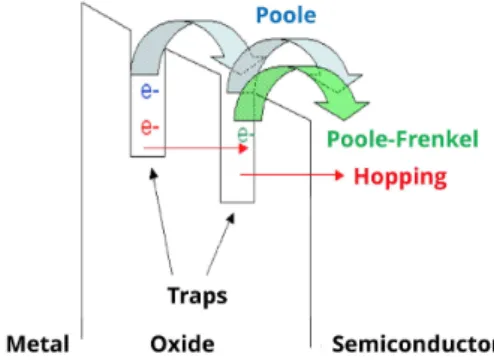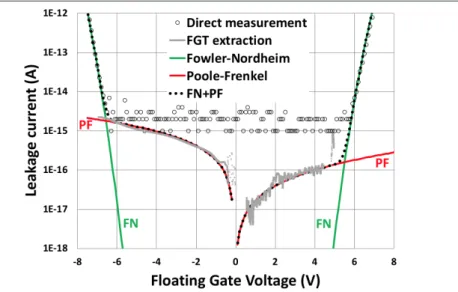HAL Id: hal-02618292
https://hal.inrae.fr/hal-02618292
Submitted on 25 May 2020
HAL is a multi-disciplinary open access
archive for the deposit and dissemination of
sci-entific research documents, whether they are
pub-lished or not. The documents may come from
teaching and research institutions in France or
abroad, or from public or private research centers.
L’archive ouverte pluridisciplinaire HAL, est
destinée au dépôt et à la diffusion de documents
scientifiques de niveau recherche, publiés ou non,
émanant des établissements d’enseignement et de
recherche français ou étrangers, des laboratoires
publics ou privés.
Distributed under a Creative Commons Attribution| 4.0 International License
in dielectrics
Jérémy Postel-Pellerin, Gilles Micolau, Philippe Chiquet, Maminirina Joelson,
Jean-Baptiste Decitre
To cite this version:
Jérémy Postel-Pellerin, Gilles Micolau, Philippe Chiquet, Maminirina Joelson, Jean-Baptiste Decitre.
A global modeling approach of the leakage phenomena in dielectrics. E3S Web of Conferences, EDP
Sciences, 2019, 88, pp.05002. �10.1051/e3sconf/20198805002�. �hal-02618292�
dielectrics
Jérémy Postel-Pellerin1,∗, Gilles Micolau2, Philippe Chiquet1, Maminirina Joelson2, and Jean-BaptisteDecitre3
1Aix-Marseille University, IM2NP, CNRS, UMR 7334, rue Enrico Fermi, 13451 Marseille, France 2Avignon University, EMMAH, UMR 1114, INRA-UAPV, 301 rue Baruch de Spinoza, 84000 Avignon,
France
3LSBB, UMS 3538, UNS/UAPV/CNRS/AMU, La Grande Combe, 84400 Rustrel, France
Abstract.Thanks to its low noise level, the LSBB environment provides par-ticular environment to carry out high quality electrical characterizations. In this paper, we propose a complete modeling approach of the experimental results from our experimental microelectronic setup. The tested device is a Metal Ox-ide Semiconductor (MOS) floating gate capacitor which can be found in elec-trostatic non volatile memories such as Flash. The main idea is to characterize and model the leakage current through the tunnel oxide. We proposed, in a pre-vious work, a model for charge loss considering a fractional Poisson process, involving only two parameters, expressed as a Mittag-Leffler (ML) function. Here, we also propose a combo of Fowler-Nordheim (FN) and Poole-Frenkel (PF) models for leakage currents, based on tunnel effect transport through the oxide. It gives the leakage current on a medium-to-long scale of time while the ML model can possibly take into account a shorter time step. The perspective is to find a relationship between these different models, used in various fields, to propose a generic model of phenomena involving leakage in complex and porous materials at different scales of time and space.
1 Introduction
Flash memory cells are based on the floating gate technology principle [1]. The most widespread solution to enable semiconductor memories to be non-volatile, that is to say able to keep information without any power supply, is to use MOS transistors whose threshold voltage is shifted by a charge stored in an isolated gate above the channel. Floating gate technologies consist in adding a second gate between the gate and the channel of a classi-cal MOS transistor. This second gate, classi-called "Floating Gate" (FG), can isolate charges to make the transistor threshold voltage variable. Charges are injected through a dielectric, in general Silicon dioxide SiO2, placed between the floating gate and the transistor channel, as presented in Fig. 1. Lastly, the two gates of this "transistor" are separated by a tri-layer stack oxide "Oxide/Nitride/Oxide" (ONO). Thus, the Flash elementary cell can be seen as a classical MOS transistor whose gate would be in series with a capacitor CPP. The floating
gate can now store a charge while the second electrode of the capacitor becomes the "Control Gate" (CG) of the cell.
Figure 1. Picture of a floating gate structure (left) and its electrical scheme (right)
Barrier transparency in the tunnel oxide, which can be electrically modeled by a current source I, allows the injection of charges in the floating gate, shifting the MOS transistor threshold voltage VT according to equation (1):
VT = VT0−
QFG
CPP
(1) where VT0 is the natural threshold voltage of the cell, QFG the charge amount in the
floating gate and CPPthe capacitance between the control gate and the floating gate.
Memory cell reliability, defined as the capability of said device to function over time, is a major issue for manufacturers and can be related to many parameters such as process and using conditions. Indeed, unceasing device scaling, decrease of dielectric thicknesses around the floating gate and high voltages applied on cells are many parameters altering memory reliability [2–5]. Thus, dielectrics’ quality is a major issue due to their antagonistic roles: avoiding electric charge leakage currents during retention phase while being transpar-ent enough during programming steps. A better understanding of these leakage currtranspar-ents is crucial to improve the whole quality of our memory cells, that’s why we have to develop powerful methods to reach very low current levels.
2 Floating Gate Technique
Most of the electrical measurements developed to characterize semiconductor devices and es-pecially Non-Volatile Memories are based on current measurements. Indeed, to study a major reliability aspect of these NVM we have to evaluate the very low-level leakage currents re-sponsible for the charge loss during the retention phase. Nevertheless, these currents are not accessible through direct measurements, even with high-performance analyzers [6], so we have to use some indirect measurement techniques to reach lower level currents. One of the most widely used technique is the "Floating-Gate Technique" (FGT), based on the use of a MOS capacitor and a MOS transistor in parallel [7, 8]. Using this method requires i) protect-ing the wafer from mechanical perturbations (vibrations) and ii) (very) long time acquisition. In a classical laboratory environment, those two constraints are generally not easy to deal with. Indeed, they lead to use, for a very long time, huge, heavy and very expensive probers (mechanically insulated by air shocks), which is often economically not possible. The main idea of our experimental platform consists in developing a "cheap" platform, presented ex-haustively with its methodology in [9–12]. The mechanical insulation is "naturally" done by the very peculiar environment of the underground LSBB Laboratory located in Apt (South of France). The direct result of the measurements is a Drain-Source current in the TMOS de-vice. After treatment consisting in interpolation with the known characteristics of this later,
i-DUST 2018
Figure 2. Results of the FGT extraction for both positive and negative floating-gate voltages
The curve of the leakage current from direct derivative of charge evolution is found to be highly noisy and is not suitable to define a clear trend for current leakage. It is directly linked to the over-sampling measurement process. Because we cannot anticipate the varia-tion of the charge during time, we choose an arbitrarily short time between two measures. One way to estimate this leakage current is to have a model whom generated curves can be derivated without issue. Two ways are explored : "deterministic" loss of charge by known microelectronics currents and relaxation law generated by random processes.
3 Modeling of the leakage current
3.1 Conduction through dielectrics in microelectronics
In microelectronics, electrons can directly tunnel through dielectrics, but conduction can also be assisted by traps existing in a damaged dielectrics.
3.1.1 Tunneling currents
Quantum mechanics, through the resolution of the Schrödinger equation, makes it possible to predict the passage of particles through a barrier having finite width and height [13]. This non-zero probability of passage of carriers, called transmission coefficient, is the cause of various conduction phenomena through the oxide, such as direct tunnel or Fowler-Nordheim (FN) tunneling [14]. Due to the relatively thick tunnel oxide (around 10nm [5]) , direct tunneling is very low but the intern electric field is high enough to enable Fowler-Nordheim mechanism, driven by two parameters denoted αFNand βFN in equation (2):
JFN = αFN.Etun2 .exp −
βFN
Etun
!
(2) In the following of this study, we will only consider FN tunneling as a mechanism possi-bly responsible for observed leakage currents.
Figure 3. Tunneling mechanisms
3.1.2 Trap-assisted mechanisms
Due to the repeated programming/erasing operations on the memory cell (and thus electrons passing through dielectrics), tunnel oxide is progressively damaged and traps are created inside it, creating additional leakage paths. Several trap-assisted mechanisms have previously been proposed in literature [15, 16], described in Fig. 4.
Figure 4. The main trap-assisted mechanisms in dielectrics
Tunnel oxide is thin enough so that the probability to have two (or more) traps aligned to create a conductive path is very low [17] and we will only consider in our modeling process the Poole-Frenkel mechanism, according to equation (3), driven by two parameters denoted αPFand βPF: JPF = αPF.Etun.exp q.βPF. √ Etun kT ! (3)
At the scale of an electrical characterization of a device, finally, only biases and flowing cur-rents are recorded. FN and PF can be discriminated because they don’t occur in the same zone of biases. Nevertheless, it is not simple to characterize a PF mechanism, because it depends on the number of traps, their geometrical characteristics, their electromagnetic behavior, etc. It can also be useful to consider that we are dealing with a transfert of material in a complex medium, described by a set of macroscopical parameters, in view to build relaxation models.
i-DUST 2018
Indeed, we can consider electrons in the floating-gate as moving particles in a box with an opening to the outside. The number of particles inside the box is a random process N(t) following a binomial law and then the mean value n at time t follows ordinary differential equation (4):
d
dtn(t) + Cc.n(t) = 0 (4) where the parameter Ccis the probability that a given particle is instantaneously outside
the box. The obvious solution is given by an exponential law (5):
n(t) = n0.exp(−Cc.t) (5)
where n0is the initial number of particles. It is a memoryless relaxation law, also known
as the disintegration law.
The modeling of the charge evolution, using Classical Poisson process, is shown in Fig 6.
3.2.2 Fractional Poisson process
If a memory effect is taken into account i.e. the probability of particle to come out is now depending on the number of remaining particles, we have a Fractional Poisson Process [18], based on the Mittag-Leffler function and on the fractional Caputo derivative of order α [19– 23]. The mean value n of number of particles at time t follows the fractional relaxation equation (6):
dα
dtαn(t) + C.n(t) = 0 (6)
4 Comparison between models and experiments
We have first considered only the FN mechanism, occurring at "high" voltage, which has been fitted on the direct measurement. We can see in Fig. 5 that this mechanism does not explain the FGT extraction and a second mechanism is necessary for lower voltages. That’s why we added the PF mechanism and the sum of the two contributions. The four parameters, αFN, βFN, αPF, βFNhave been optimized in order to model both direct measurement (over the
Figure 5. Modeling of both direct measurement and FGT extraction, using a combo of FN and PF mechanisms. αF N = 7.1 × 10−4A/V2, βF N = 2.55 × 1010V/m, αPF = 1.26 × 10−16A/(V.m), βF N =
5 × 10−7(V.m)1/2
We present, then, the comparison between measurements and the relaxation processes models. The parameters of the relaxation models have been optimized in order to fit only the FGT measurements. Two models are explored : the classical Poisson model (one parameter Cc) and the fractional Poisson Processes. For this latests, two set of parameters are proposed.
The first one (C1, α1) is optimized in order to fit the upper part of the experimental
mea-surements of the charge (short times), while the second one (C1, α1) is optimized to fit the
lower part of the curve (long times). Fig 6 shows the modeling of the charge evolution, using Classical Poisson (one parameter Cc) and Fractional Poisson processes (four parameters).
Figure 6. Three models of relaxation compared to the extracted values of the charge versus time. Two fractional models are proposed, for the upper part and the lower part of the curve. The parameters are : Cc=4 × 10−7s−1, α1=0.8922, C1=3.285s−α1,α2=0.964, C2=2.85s−α2
i-DUST 2018
Figure 7. Three models of relaxation compared to the extracted values of the leakage current, from charge evolutions in Fig. 6.
It appears that the three relaxation models are close to the shape of the FGT measurements for biases between 0.5 and 4.5 V. They don’t succeed in fitting upper biases of the floating gate. It can be interpreted by the fact that for biases greater than 4.5 V, the deterministic FN current becomes the major way of electrons transfert through the oxide. Looking at Fig.5, we denote that FN current is the greatest when the floating gate voltage rises around 5 V. Let us insist on the fact that for the Poisson relaxation models, either classical or fractional, only the measurements of charge versus time are necessary, while for FN and PF models, a model is needed to link the floating gate voltage to the electric field in the oxide.
Finally, to summarize, we present in figure 8, in logarithmic scale, all the models and the measurements in the same figure. Fractional Poisson processes give a good agreement with measurements for biases lower than 1.5 V.
Figure 8. All models compared to the extracted values of the leakage current, from datas in Fig. 5 and 7.
5 Conclusion
We present here two different approaches for fitting ultimate measurements of current leak-age in a floating gate device. The first one is based on deterministic physical formulations of charge transfert in insulators. The second approach is based on stochastic formulations involving processes with memory effect, according to the fact that the oxide could be seen as a complex material in which displacements are resulting from numerous interactions. These two approaches give a good agreement in the long time range behavior of the charge loss in the device, corresponding to low biases of the floating gate.
We can explore two main ways of perspective. The first one should be a theoretical approach linking fractional Poisson process with trap assisted currents as Poole-Frenkel. The second way of perspectives lyes in increase the capability of our experimental platform adding a ca-pacitance meter (allowing to monitor the damages of the oxide) and a better mechanical and optical system (allowing larger wafers with smaller devices).
References
[1] W. Brown and J. Brewer, Nonvolatile semiconductor memory technology: a comprehen-sive guide to understanding and to using NVSM devices(IEEE Press, 1998)
[2] P. Canet et al., Proc. of IEEE ISCAS, pp. 846-849 (2001) [3] P. Canet et al., Proc. of IEEE MWSCAS, pp. 1144-1147 (2000) [4] P. Canet et al., Proc. of IEEE ESSCIRC, pp. 683-686 (2002) [5] ITRS, Process Integration, Devices, and Structures (2013)
[6] Keysight, B1500A Semiconductor Device Analyzer data sheet (October 2016) [7] B. Fischbein et al., IEEE Elec. Dev. Lett. 12, pp. 713-715 (1991)
[8] F.H. Gaensslen et al., IEEE Elec. Dev. Lett. 1, pp. 231-233 (1980) [9] J. Postel-Pellerin et al., Proc. of IMEKO TC4, pp. 1041-1045 (2014) [10] J. Postel-Pellerin et al., Acta Imeko 4, pp. 36-41 (2015)
[11] J. Postel-Pellerin et al., Proc. of IEEE CAS, pp. 287-290 (2014) [12] G. Micolau et al., Proc. of iDUST 2, pp. 1-9 (2016)
[13] C. Cohen-Tannoudji, B. Diu, and F. Laloe, Mécanique Quantique, (Hermann, 1998) [14] R.H. Fowler and L. Nordheim, Proc. of the Royal Soc. of London A 119, pp. 173-181
(1928)
[15] R.E. Shiner et al., Proc. of IEEE IRPS, pp. 238 (1980) [16] N.R. Mielke, Proc. of IEEE IRPS, pp. 106 (1983)
[17] J.H. Stathis, Journ. of Appl. Phys. 86, pp. 5757-5766 (1999)
[18] N. Laskin et al., Comm. in Nonlin. Sci. and Sim. 8, pp. 201-213 (2003) [19] M.-C. Neel et al., Proc. of Dyn. Frac. Appl. (2010)
[20] J. Golder et al., Math. and Comp. in Sim. 81, pp. 2181-2189 (2011) [21] J. Golder et al., Water Sci. and Engineering 7, pp. 32-40 (2014)
[22] D. Sierociuk et al., IEEE Trans. on Control Syst. Technology 21, pp. 459-466 (2011) [23] A.A. Kilbas et al., Integral Transform and Spec. Func. 15, pp. 31-49 (2004)
i-DUST 2018




